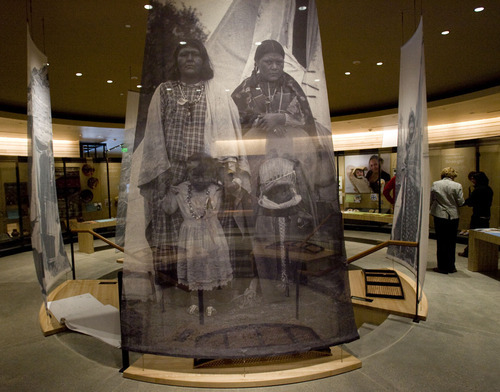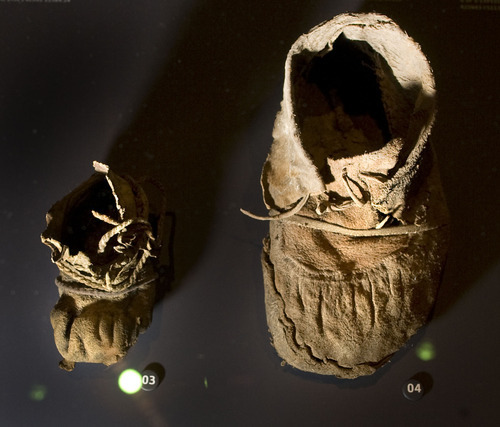This is an archived article that was published on sltrib.com in 2011, and information in the article may be outdated. It is provided only for personal research purposes and may not be reprinted.
The galleries, or observatories, in the new Natural History Museum of Utah are organized around themes ranging from the Great Salt Lake ecosystem to Utah's first human inhabitants:
Native Voices • In a museum filled with cutting-edge displays, this homage to Utah's Indian tribes is the most traditional in presentation. However, the museum departed from tradition in curating this circular exhibit by allowing tribes to tell their stories and to greet visitors in their own voices and native tongues. The space occupies a round structure, invoking the kiva of Ancestral Puebloan architecture, at the museum's uppermost level. Tribes covered are the Ute, Paiute, Navajo, Shoshone and Goshute, whose representatives chose the objects on display.
The Canyon • The museum's central space, evoking a slot canyon spanned by natural bridges, is an admission-free area where visitors enter the building's main level. A relief map of Utah is embedded in the floor and the north wall features a floor-to-ceiling display of 500 objects from the museum collections, arranged as a work of art. Projected on the opposite wall is a dynamic installation by Dutch artist Simon Heijdens, which changes in response to the environment. This space also includes the Trailhead, where visitors launch their journey through the museum with the help of interactive displays that allow them to personalize their tour.
First Peoples • Here visitors can learn about archeology, a discipline that melds anthropology and geography with hard sciences to study people who inhabited the land long ago. The museum's largest hands-on exhibit replicates an excavation. Displays feature the art, tools, weapons, and clothes of the Fremont and Ancestral Puebloans who occupied the Colorado Plateau 1,000 years ago, as well as cultures that preceded them.
Life • This observatory moves from the micro layers of genetic code and cells to the macro-world of habitats and ecosystems. Highlights include four dioramas depicting Utah's major landscapes types — low desert, high desert, montane and alpine. All feature audio adapted from the University of Utah's Western Soundscape Archive. To experience a foothill ecosystem, visitors can step out to an adjacent patio and check out the real thing.
The Land • Somewhere near Nephi, three major land forms come together: the Colorado Plateau, Rocky Mountains, and Basin and Range. This gallery reveals the forces that formed these regions over millions of years and explains Utah's striking geological strata, including the sandstone, granite, slate and the limestone that has yielded rich troves of fossils.
Lake and Sky • The Great Salt Lake, Utah's signature body of water, is the saline remnant of an inland sea called Lake Bonneville that drained thousands of years ago. The new museum is built above a bench formed by Bonneville's old shoreline. The Lake gallery captures this history as well as the Great Salt Lake's amazing chemical properties and wildlife. The Sky is an indoor-outdoor observatory that spills onto a rooftop deck where visitors can appreciate the weather and views of the mountains, valley and, of course, the lake.
Past Worlds • With its bones, bones and more bones, this gallery covers the past 225 million years, from the Jurassic to the Pleistocene. One wall is covered with the frilled skulls of dinosaurs called ceratopsids, famous for their horns and beaks, arranged to show their evolutionary relationships. Skeletons of early Eoncene mammals and the dinosaurs that came before are mounted in dynamic poses reflecting current knowledge. The mount of a gryposaurus contains feature real bone recovered from Grand Staircase Escalante National Monument, rather than casts.















